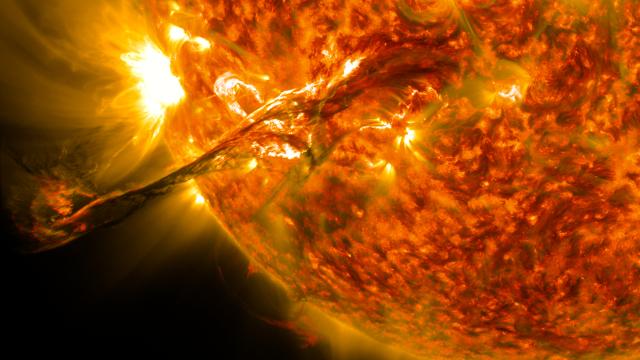Do not underestimate the Sun.Image: NASA/Goddard Space Flight Center
Are you always careful to apply sunscreen before a day outdoors, but find yourself getting burned anyway? It might be due to your application technique. Dermatologists say that most people don’t put on a thick enough layer sunscreen, and new research — in which scientists put varying amounts of sunscreen on volunteers’ butts — shows how those thin applications of sunscreen fail to provide the SPF listed on the bottle.
Truthfully, it’s hard to really know whether you’ve applied enough sunscreen. The FDA tests SPF on humans at a thickness of 2 milligrams per square centimeter of skin — but in the real world, most people just squirt an unmeasured dollop into their hands and rub it in a thin layer over their skin. For the average face, a quarter-teaspoon of lotion is needed to get the SPF listed on a given sunscreen. Body surface area varies a lot, but the American Academy of Dermatology recommends slathering on one fluid ounce, or a shot glass’ worth, to get the listed SPF.
In this new experiment, the researchers are the first to look at how thick and thin sunscreen applications result in different amounts of UV damage to DNA, according to the study published Tuesday in Acta Dermato-Venereology. They found that when applied typically, SPF 50 sunscreen offered just 40 per cent of expected protection from sunburn.
Thankfully, that reduced protection from both sunburn and also Sun-caused DNA damage is actually pretty adequate if a person is using a high SPF like 50, according to the paper. Which is why using a product that’s only SPF 15 isn’t a good bet.
To figure this out, the researchers applied sunscreen layers of varying thicknesses to the “upper buttocks” of 16 fair-skinned people and exposed them to UV light using a specialised lamp.
Some people were exposed to UV rays just once, and others were exposed repeatedly for five days to simulate the sunlight one might get on a vacation. The researchers even calibrated some of the UV ray intensity to match what one might experience in Florida, Brazil, or Tenerife.
After those exposures, the researchers did tiny punch biopsies of the areas to quantify how much the UV rays had damaged the skin cells’ DNA. To do so, they used chemical analyses to count the number of thymine dimers, or mis-bonded pieces of DNA that are related to the formation of skin cancer. (The researchers chose to use the participants’ butts because its an area of the body seldom exposed to the sun, and it’s also fatty and easy to take a biopsy from.)
For unprotected skin, the damage was greatest under repeated exposure, even at low UV ray intensity. But that damage was reduced considerably with even just a thin layer of sunscreen, akin to typical use (0.75 milligrams of sunscreen per square centimeter). With the thickness tested by the FDA, 2.0 milligrams per square centimeter, damage was reduced even more — but not by much.
“If you use sunscreen suboptimally, applying it at 40 per cent of the thickness it’s tested at, you’re still getting a very good level of protection from DNA damage,” Antony Young, a dermatologist at King’s College London and study author, told Gizmodo.
But the researchers only tested broad-spectrum sunscreen with an SPF of 50. Forty per cent of SPF 50 would translate to SPF 20 — that hovers just above the FDA minimum suggestion of broad spectrum SPF 15. Most dermatologists will suggest at least an SPF 30, especially for fair-skinned people.
But with a typical slather of SPF 30, you’d be getting the protection an SPF 12 sunscreen. And, more alarmingly, SPF 15 sunscreen would only offer around SPF 6. These numbers are all estimates based on protection from SPF 50 sunscreen in this study, of course, and will most definitely vary in practice.
For context, when applied correctly, a sunscreen with an SPF of 15 blocks 93 per cent of UVB rays (the UV rays that cause skin burning), according to the American Cancer Society. SPF 30 blocks 97 per cent, SPF 50 blocks 98, and SPF 100 blocks 99 per cent.
The thought that we aren’t getting as much sun protection as we think we are is a very concerning one. The American Cancer Society estimates that 91,270 new cases of melanoma will be diagnosed in the United States this year, and that over 9,000 of them are expected to be fatal. Rates of melanoma have also been on the rise in the last three decades.
Plus, Young said our misapplication of broad-spectrum sunscreen is also putting us at risk for premature ageing. That’s because we’re probably blocking fewer UVA rays than we think, which contribute to the breakdown of collagen. Down the line, that can cause saggy skin, wrinkles, and spots.
To avoid these things, Young has a few tips. The first is to apply sunscreen twice. Do the first layer, wait 10 or 15 minutes, and then do another thorough layer just like the first — using this strategy might help more people reach the right thickness of application, he said.
Secondly, Young urges people to purchase sunscreen products with a higher SPF, like 50, to combat the protection being lost from thin application. And of course, you’ve got to reapply sunscreen every two hours, or after swimming or toweling off.
But no sunscreen can fully protect you from DNA damage from the sun, which is why dermatologists recommend you also seek shade and wear protective clothing, including a hat.
“Even with sunscreen, we see some genetic changes,” Steven Feldman, a dermatologist at the Wake Forest University School of Medicine who was not involved with the recent study, told Gizmodo. “Wearing a big floppy hat or a protective shirt might not be such a bad thing, either.”
